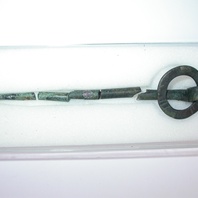
Viking Objects
Ring-headed Pin (2004-311-sf245)
This ring-headed pin was uncovered in a cremation burial which was generally unfurnished and containing little evidence. This type of pin was fairly common throughout the Viking Age and was used to hold a cloak around one’s body.
Read More
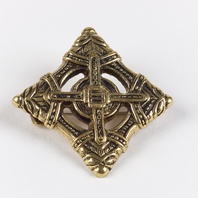
Viking Objects
Reproduction Lozenge Brooch
A copper alloy lozenge brooch in the Borre style based off a find in Lincolnshire. This type of brooch was common throughout the Danelaw in the Viking Age and was used as an accessory by women who wore Scandinavian dress. Scandinavian brooches came in a variety of sizes and shapes which included disc, trefoil, lozenge, equal-armed, and oval shapes. The different brooch types served a variety of functions in Scandinavian female dress with oval brooches typically being used as shoulder clasps for apron-type dresses and the rest being used to secure an outer garment to an inner shift. Anglo-Saxon brooches do not match this diversity of form with large disc brooches being typical of ninth century dress styles with smaller ones becoming more popular in the later ninth and tenth centuries. However, since disc brooches were used by both Anglo-Saxon and Scandinavian women they are distinguished by their morphology. Scandinavian brooches were typically domed with a hollow back while Anglo-Saxon brooches were usually flat. Moreover, Anglo-Saxon brooches were worn singly without accompanying accessories.
Read More
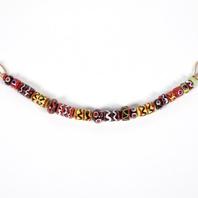
Viking Objects
Reproduction Baltic Glass Beads
This glass-bead set is based on originals from Ribe/Hedeby and the Baltic and were meant to be worn between oval brooches. Glass beads were a coveted item with some being imported from as far away as the Middle East. They were manufactured by specialised artisans who would heat various coloured glass rods over a furnace and melt the glass onto a metal stick to form different shaped beads.
Read More
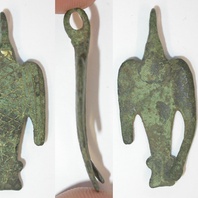
Viking Objects
Bird Pendant (DENO-55AE35)
A pendant of similar shape although with different decoration is dated to the second half of the ninth century from Yaroslavl, Russia. The bird symbol, very similar to the one depicted on this pendant, was used by the Rurik dynasty which had started the conquest of Slavic lands in the mid-ninth century and later formed the polity of Rus’. With some exceptions, pendants were generally worn by women as an accessory to Scandinavian dress.
Read More
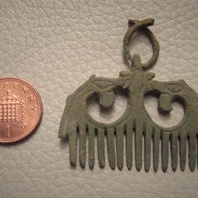
Viking Objects
Comb Pendant (NARC-B3E1B5)
This pendant is unusual for the British isles and has Eastern Scandinavian or Baltic origin. The pendant is decorated with Ringerike-style zoomorphic openwork ornament with a pair of inturning zoomorphic heads. Pendants were a popular dress accessory in Norway and Sweden and sometimes were worn with beads between a pair of oval brooches. In England, pendants did not have the same popularity and there do not seem to be any contemporary Anglo-Saxon pendants.
Read More
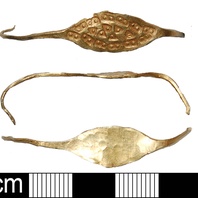
Viking Objects
Gold Finger-Ring (BH-59ECD3)
An Anglo-Scandinavian gold finger-ring decorated with a punched a lozenge-shaped pattern of six triangles with central dots, surrounded by a circumferential band of punched rectangles with two dots. The ends of the wires are hooked, showing that they would originally have been twisted together. Rings like this with knotted ends are typically Scandinavian.
Read More
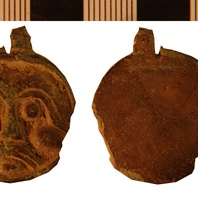
Viking Objects
Copper-Alloy Disc Pendant (NLM-0CA344)
This cast copper-alloy disc pendant has an anthropomorphic design which portrays a facing moustachioed mask. A dark grey coating on front and back may be the degraded remains of a silvered surface. Pendants were a popular dress accessory in Norway and Sweden and sometimes were worn with beads between a pair of oval brooches. For more information on Scandinavian jewellery in England check out our blog: Brooches, Pendants and Pins: Scandinavian Dress Accessories in England.
Read More
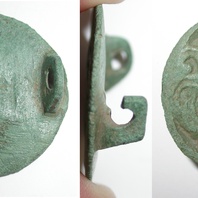
Viking Objects
Borre Style Brooch (DENO-805B20)
This copper-alloy brooch is an example of Kershaw’s East Anglian series and is decorated with interlaced Borre-style designs. For more information on Scandinavian jewellery in England check out our blog: Brooches, Pendants and Pins: Scandinavian Dress Accessories in England.
Read More
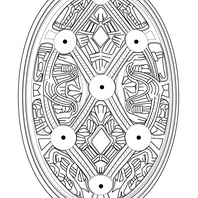
Viking Designs
Drawing of Oval Brooch
Drawing of an oval brooch based on examples for Adwick le Street, Doncaster. Brooches were a typical part of female dress. Scandinavian brooches came in a variety of sizes and shapes which included disc, trefoil, lozenge, equal-armed, and oval shapes. The different brooch types served a variety of functions in Scandinavian female dress with oval brooches typically being used as shoulder clasps for apron-type dresses and the rest being used to secure an outer garment to an inner shift. Anglo-Saxon brooches do not match this diversity of form with large disc brooches being typical of ninth century dress styles with smaller ones becoming more popular in the later ninth and tenth centuries. However, since disc brooches were used by both Anglo-Saxon and Scandinavian women they are distinguished by their morphology. Scandinavian brooches were typically domed with a hollow back while Anglo-Saxon brooches were usually flat. Moreover, Anglo-Saxon brooches were worn singly without accompanying accessories.
Read More
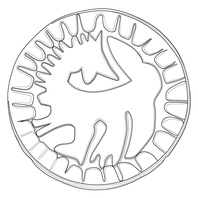
Viking Designs
Drawing of a Brooch with Backwards-Facing Beast
Drawing of a disc brooch found at South Ferriby, Lincolnshire with a backwards-facing beast motif. For more information on Scandinavian jewellery in England check out our blog: Brooches, Pendants and Pins: Scandinavian Dress Accessories in England.
Read More
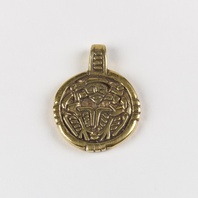
Viking Objects
Reproduction Pendant with an Odin Motif
This reproduction of a cast silver, gilded pendant featuring an image of a one-eyed figure with two birds has been interpreted as Odin and his two ravens, Huginn and Muninn. The original pendant was found at Winteringham, Lincolnshire. There are a number of close parallels which establish the wide currency of this subject group. These include numerous examples from Russia and two from Sweden, including some with silver gilding. A silver pendant with a related, but distinct design is known from Sjælland, Denmark.
